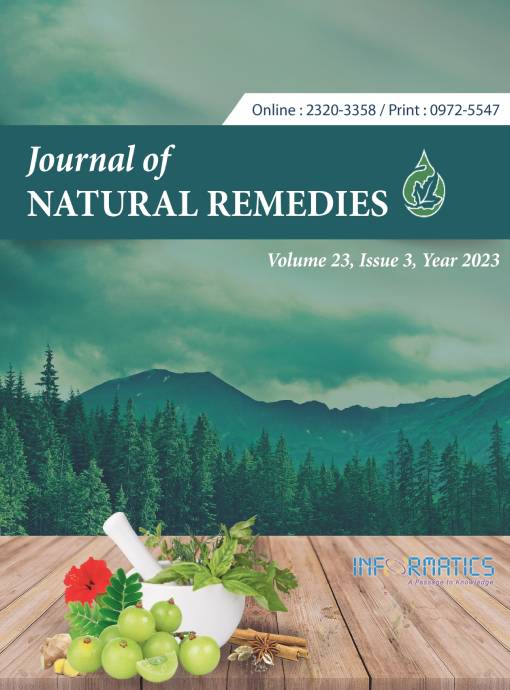Therapeutic Influence of Nyctanthes arbor-tristis against Aluminum Chloride-induced Impairment in Wistar Rats
DOI:
https://doi.org/10.18311/jnr/2023/34092Keywords:
Aluminum Chloride-induced Dementia Model, Alzheimer’s Disease, Memory Impairment, Neuroprotective Activity, Nyctanthes arbor-tristislongAbstract
Background: Alzheimer’s Disease (AD) is a neurological illness that causes cognitive decline and memory loss. The identification of potential therapeutic agents with neuroprotective properties is of great interest in AD research. This study aimed to evaluate the neuroprotective activity of the ethanolic extract of Nyctanthes arbor-tristis in an aluminium chloride-induced dementia model in Wistar rats. Materials and Methods: Nyctanthes arbor-tristis plant specimens were collected, and ethanolic extract was prepared using standard extraction procedures. Four groups of Wistar rats were formed: control, aluminium chloride-induced dementia, extract-treated, and standard drug-treated groups. Neurobehavioral changes were measured using the elevated plus maze test and Hebb’s William apparatus. Plasma levels of amyloid-beta 1-42 (Aβ1-42) were measured. A histopathological examination of brain tissues was conducted to assess structural changes. Results: The ethanolic extract of Nyctanthes arbor-tristis demonstrated significant neuroprotective effects in the aluminium chloride-induced dementia model. Treatment with the extract improved neurobehavioral changes associated with memory impairment and improved learning and memory performance in the Hebb’s William apparatus and elevated plus maze. Moreover, the extract significantly reduced plasma levels of Aβ1-42, indicating its potential as an anti-Alzheimer’s agent p < 0.001. Histopathological analysis revealed a reduction in neuronal damage and restoration of normal brain tissue architecture in the extract-treated group. Conclusion: The ethanolic extract of Nyctanthes arbor-tristis exhibits neuroprotective activity in an aluminium chloride-induced dementia model in Wistar rats. The extract improves neurobehavioral changes related to memory, decreases plasma levels of Aβ1-42, and ameliorates histopathological alterations in the brain.
Downloads
Metrics
Downloads
Published
How to Cite
Issue
Section
License
Copyright (c) 2023 Vishnu Prabhakar, Avijit Mazumder, Saumya Das, Anmol Kanda, Tanya Singh (Author)

This work is licensed under a Creative Commons Attribution 4.0 International License.
Accepted 2023-07-18
Published 2023-08-31
References
Singla RK, Joon S, Sinha B, Kamal MA, Simal-Gandara J, Xiao J, et al. Current trends in natural products for the treatment and management of dementia: Computational to clinical studies. Neurosci Biobehav Rev. 2023; 147:105106. https://doi.org/10.1016/j.neubiorev.2023.105106 PMid: 36828163 DOI: https://doi.org/10.1016/j.neubiorev.2023.105106
Ullah H, Hussain A, Asif M, Nawaz F, Rasool M. Natural products as bioactive agents in the prevention of dementia. CNS Neurol Disord Drug Targets. 2022; 22(4):466–76. https://doi.org/10.2174/1871527321666220422085835 PMid:35466886 DOI: https://doi.org/10.2174/1871527321666220422085835
Ju Y, Tam K. Pathological mechanisms and therapeutic strategies for Alzheimer’s disease. Neural Regen Res. 2022; 17(3):549. https://doi.org/10.4103/1673-5374.320970 PMid:34380884 PMCid:PMC8504384 DOI: https://doi.org/10.4103/1673-5374.320970
Agrawal J, Pal A. Nyctanthes arbor-tristis Linn—A critical ethnopharmacological review. J Ethnopharmacol. 2013; 146(3):645–58. https://doi.org/10.1016/j.jep.2013.01.024 PMid:23376280 DOI: https://doi.org/10.1016/j.jep.2013.01.024
Pandrangi LS, Chalumuri SS, Chittineedi P, Garimella S, leader G. Therapeutic potential of Nyctanthes arbor-tristis on cancer and various diseases. Ann Rom Soc Cell Biol. 2022; 26(01):1690–701.
Jamadagni SB, Ghadge PM, Tambe MS, Srinivasan M, Prasad GP, Jamadagni PS, et al. Amelioration of AlCl3 -induced memory loss in the rats by an aqueous extract of Guduchi, a Medhya Rasayana. Pharmacogn Mag. 2023; 19(2):231–43. https://doi.org/10.1177/09731296221145063 DOI: https://doi.org/10.1177/09731296221145063
Abubakar AR, Haque M. Preparation of medicinal plants: Basic extraction and fractionation procedures for experimental purposes. J Pharm Bioallied Sci. 2020; 12(1):10. https://doi.org/10.4103/jpbs.JPBS_175_19 PMid:32801594 PMCid:PMC7398001 DOI: https://doi.org/10.4103/jpbs.JPBS_175_19
Banu SK, Cathrine L. General techniques involved in phytochemical analysis. International Journal of Advanced Research in Chemical Science (IJARCS). 2015; 2(4):25– 32.
Lee NC, Chien YH, Hwu WL. A review of biomarkers for alzheimer’s disease in down syndrome. Neurol Ther. 2017; 6(Suppl 1):S69–81. https://doi.org/10.1007/s40120-017- 0071-y PMid:28733957 PMCid:PMC5520817 DOI: https://doi.org/10.1007/s40120-017-0071-y
Khan H, Ullah H, Aschner M, Cheang WS, Akkol EK. Neuroprotective effects of quercetin in alzheimer’s disease. Biomolecules. 2020; 10(1):1–20. https://doi.org/10.3390/ biom10010059 PMid:31905923 PMCid:PMC7023116 DOI: https://doi.org/10.3390/biom10010059
Kouhestani S, Jafari A, Babaei P. Kaempferol attenuates cognitive deficit via regulating oxidative stress and neuroinflammation in an ovariectomized rat model of sporadic dementia. Neural Regen Res. 2018; 13(10):1832. https://doi.org/10.4103/1673-5374.238714 PMid:30136699 PMCid:PMC6128063 DOI: https://doi.org/10.4103/1673-5374.238714
Nguyen HT, Le XT, Nguyen VT, Phung HN, Pham HTN, Nguyen KM, et al. Ursolic acid and its isomer oleanolic acid are responsible for the anti-dementia effects of Ocimum sanctum in olfactory bulbectomized mice. J Nat Med. 2022; 76(3):621–33. https://doi.org/10.1007/s11418-022-01609-2 PMid:35218459 DOI: https://doi.org/10.1007/s11418-022-01609-2
Butterfield DA, Boyd-Kimball D. The critical role of methionine 35 in Alzheimer’s amyloid β-peptide (1–42)-induced oxidative stress and neurotoxicity. Biochimica et Biophysica Acta (BBA) - Proteins and Proteomics. 2005; 1703(2):149–56. https://doi. org/10.1016/j.bbapap.2004.10.014 PMid:15680223 DOI: https://doi.org/10.1016/j.bbapap.2004.10.014
Basta CP, De Vasconcellos CSA, Hawash ASZ, Yassien EM, Alotaibi BS, El-Moslemany AM, et al. Assessment of antialzheimer pursuit of jambolan fruit extract and/or choline against AlCl3 toxicity in rats. Toxics. 2023; 11(6):509. https://doi.org/10.3390/toxics11060509 PMid:37368609 PMCid:PMC10305215 DOI: https://doi.org/10.3390/toxics11060509
Parekh KD, Dash RP, Pandya AN, Vasu KK, Nivsarkar M. Implication of novel bis-imidazopyridines for management of Alzheimer’s disease and establishment of its role on protein phosphatase 2A activity in the brain. Journal of Pharmacy and Pharmacology. 2013; 65(12):1785–95. https://doi.org/10.1111/jphp.12149 PMid:24117507 DOI: https://doi.org/10.1111/jphp.12149
Kumar A, Dogra S, Prakash A. Protective effect of curcumin (Curcuma longa), against aluminium toxicity: Possible behavioural and biochemical alterations in rats. Behavioural Brain Research. 2009; 205(2):384–90. https:// doi.org/10.1016/j.bbr.2009.07.012 PMid:19616038 DOI: https://doi.org/10.1016/j.bbr.2009.07.012
Morales-Delgado N, Popović N, De la Cruz-Sánchez E, Bleda CM, Popović M. Time-of-day and age impact on memory in elevated plus-maze test in rats. Front Behav Neurosci. 2018; 12:437596. https://doi.org/10.3389/fnbeh.2018.00304 PMid:30574075 PMCid:PMC6291441 DOI: https://doi.org/10.3389/fnbeh.2018.00304
Erazi H, Sansar W, Ahboucha S, Gamrani H. Aluminum affects the glial system and behaviour of rats. C R Biol. 2010; 333(1):23–7. https://doi.org/10.1016/j.crvi.2009.09.016 PMid:20176332 DOI: https://doi.org/10.1016/j.crvi.2009.09.016

 Vishnu Prabhakar
Vishnu Prabhakar









 0.35
0.35 24
24 0.161
0.161